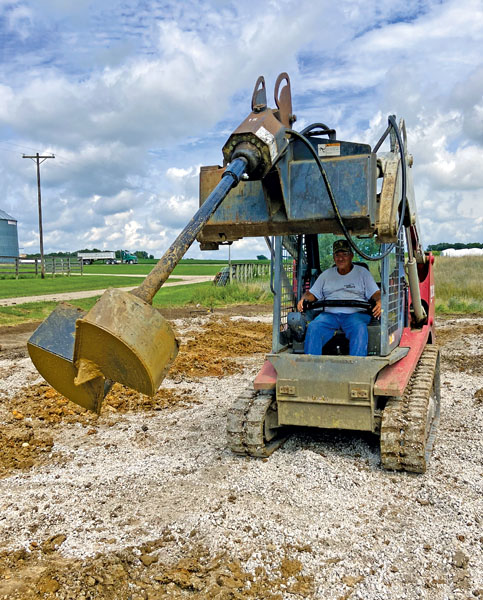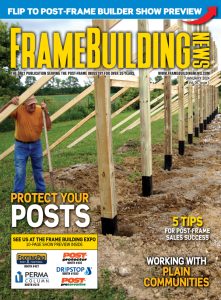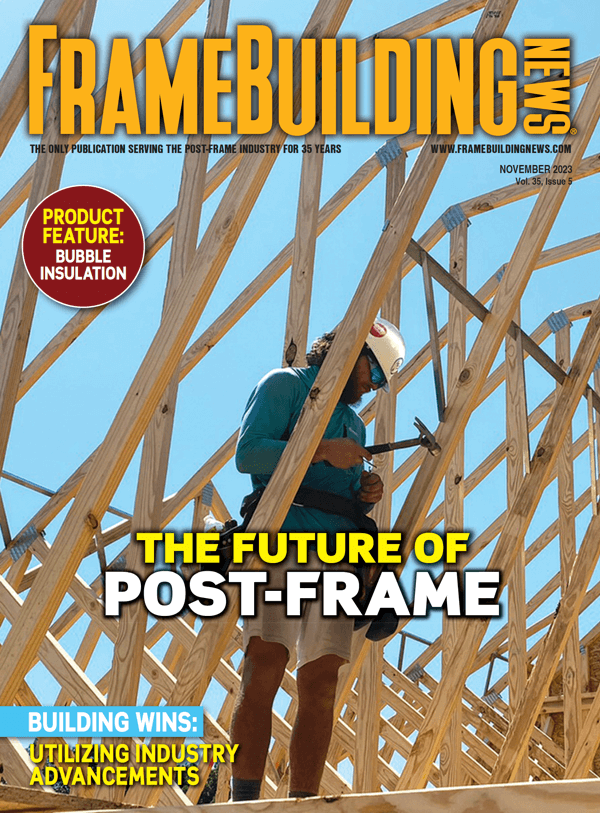By Karen Knapstein
The inability to fill work crews is a serious problem for builders with backlogs to work through. There are glimmers of hope that more young people will enter the skilled trades. Here and there, high schools are once again adding industrial arts classes to the curriculum. But that’s no help in the present.
To help offset today’s labor shortages, some in the industry are developing tools and systems to reduce or eliminate some of the physical labor necessary in construction, or reduce the number of people needed to complete specific tasks.
One such system meant to reduce the amount of labor necessary for putting up a post-frame building is the Rapid Framing System. Co-invented by Dwayne Borkholder and Todd Meinhold, the Rapid Framing System was introduced at the 2022 Frame Building Expo. Working together, the duo has developed a system they believe may revolutionize the post-frame industry.
“We’d just received our provisional patent, so we felt good about going public with it at Frame Building Expo,” says Borkholder. “We felt very honored at the show because there were a lot of people congregating around the booth. We felt we had a lot of good, positive feedback. We had good feedback from all three customer categories: builders themselves, manufacturers, and some corporate like Simpson’s Strong-Tie and Mitek.”

In essence, Borkholder says, the Rapid Framing System introduces prefab wall systems into the post-frame industry. In traditional post-frame, each step of the construction process can involve several separate tasks, with each task requiring multiple people. “Erecting a building has a whole series of tasks just to get the walls up and braced and plumb,” he explains. For example, setting and making sure the posts are plumb, marking out and putting girts on posts, post bracing, and leveling are each separate tasks that require more than one person. The Rapid Framing System eliminates some of the tasks altogether, and most of the tasks that remain require fewer people.
In a nutshell, this new system involves setting posts and then attaching pre-fabricated, framed wall sections to those posts. Posts need only be set at the corners and where wall panels meet. Once the posts are set, it only takes three workers to install the prefabricated wall sections: one on the skid steer setting the panels in place, and two on the ground to fasten them. “Once you hang all four sides, the building is going to be square, it’s going to be braced, and it’s going to be framed completely,” explains Borkholder. “It’s revolutionary. It’s stronger and faster.”
Wall panels are built off-site using truss plate connectors, which give the panels additional rigidity. Window and door openings are framed into the prefabricated wall sections as they are manufactured off-site. Headers are also already incorporated into the wall panels so once the panels are fastened in place at the jobsite, setting trusses can begin.
Meinhold has been testing the Rapid Framing System at H&D Quality Builders. “Todd is integrating the field part of it and giving feedback,” Borkholder says. He’s been documenting builds with the new system with videos and time studies to determine how much time and labor is saved. What he has found is they’ve been able to take a man off the framing crew, which is the equivalent of a 25% savings in framing labor. Three workers can do the same job on the jobsite as it would take four or even five workers with the traditional post-frame building method.

Another labor-saver is the Badger. Invented by Todd Meinhold, the Badger is a hole cleaning tool that takes a lot of the tedious and time-consuming handwork out of the post-setting process. “To really get good soil compaction for the foundation, whether you’re using a precast concrete donut for a smaller building or pouring concrete into the hole, the best way to ensure there’s solid compaction at the bottom of the hole is to clean out the loose dirt that an auger doesn’t scoop up,” says Meinhold. Conversely, in muddy conditions, the mud doesn’t want to come out of the auger. Or it leaves a bunch of loose mud at the bottom. “The loose dirt will dry out and also compact over time by compressing the air out of the soil…which will in-turn cause potential settling.”
In addition to assuring the post has a solid foundation, the hole cleaning tool also takes a lot of physical labor out of digging post holes, which helps when it comes to finding someone to do that particular task. Meinhold explains: “We’re losing young workers; it used to be when a new person came in, their job was to clean the hole.” But there aren’t as many young workers coming into the trade anymore. “When you lose that [young] labor force, you need to figure out how to extend the working life of a worker, but keep up the productivity.”
Taking the physicality out of the job was the answer. “We went from a three-man crew digging and cleaning holes to one 75-year-old guy — working part time — digging and cleaning holes.”
Meinhold is developing more labor-saving tools. He says, “Everybody can be creative and inventive to figure out ways to work around the shortage or situations they have when it’s their own business.” Which leads one to wonder: What other tools are being developed to help remedy the pains caused by labor shortages? FBN


















